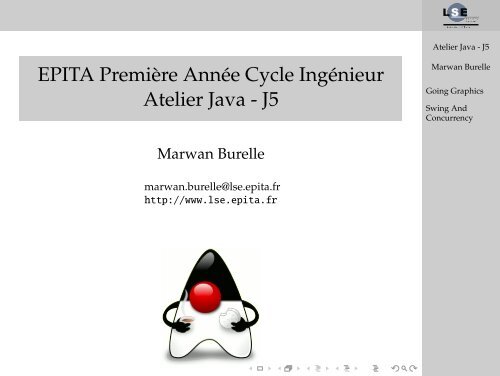EPITA Première Année Cycle Ingénieur Atelier ... - wiki-prog - Epita
EPITA Première Année Cycle Ingénieur Atelier ... - wiki-prog - Epita
EPITA Première Année Cycle Ingénieur Atelier ... - wiki-prog - Epita
You also want an ePaper? Increase the reach of your titles
YUMPU automatically turns print PDFs into web optimized ePapers that Google loves.
<strong>EPITA</strong> <strong>Première</strong> <strong>Année</strong> <strong>Cycle</strong> <strong>Ingénieur</strong><br />
<strong>Atelier</strong> Java - J5<br />
Marwan Burelle<br />
marwan.burelle@lse.epita.fr<br />
http://www.lse.epita.fr<br />
<strong>Atelier</strong> Java - J5<br />
Marwan Burelle<br />
Going Graphics<br />
Swing And<br />
Concurrency
Overview<br />
1 Going Graphics<br />
2 Swing And Concurrency<br />
<strong>Atelier</strong> Java - J5<br />
Marwan Burelle<br />
Going Graphics<br />
Swing And<br />
Concurrency
Going Graphics<br />
Going Graphics<br />
<strong>Atelier</strong> Java - J5<br />
Marwan Burelle<br />
Going Graphics<br />
Swing And<br />
Concurrency
Different toolkits<br />
• AWT: the good-old one, lakes some features and has<br />
a plateform specific look’n’feel (anyway, AWT is<br />
deprecated)<br />
• Swing: a better AWT with a unified Look’n’feel and<br />
better drawing algorithms.<br />
• SWT: the toolkit from Eclipse backed on native<br />
toolkits.<br />
<strong>Atelier</strong> Java - J5<br />
Marwan Burelle<br />
Going Graphics<br />
Swing And<br />
Concurrency
Swing<br />
• Swing could have been a demonstration of classical<br />
design patterns in action, the whole concept heavily<br />
relies on:<br />
• Decorator<br />
• Composite<br />
• Facade<br />
• Chain of responsibility (internal)<br />
• A graphical application in Java can be seen as tree<br />
(Composite) rooted by a JFrame and where nodes are<br />
widget and layout.<br />
• The layout concept help you hierarchically describes<br />
your interface and provide a nive way to organize<br />
your widget<br />
• The whole API is event-driven meaning that all you<br />
have to do is to connect event and operations<br />
triggered by those events.<br />
<strong>Atelier</strong> Java - J5<br />
Marwan Burelle<br />
Going Graphics<br />
Swing And<br />
Concurrency
SwingSet2 demo<br />
<strong>Atelier</strong> Java - J5<br />
Marwan Burelle<br />
Going Graphics<br />
Swing And<br />
Concurrency
Exploring The BorderLayout<br />
SimpleFrame<br />
import javax.swing.*;<br />
import java.awt.BorderLayout;<br />
import java.awt.Container;<br />
import java.awt.Dimension;<br />
public class SimpleFrame {<br />
public static void main(String[] args) {<br />
javax.swing.SwingUtilities.invokeLater(<br />
new Runnable() {<br />
public void run() { show(); }<br />
}<br />
);<br />
}<br />
}<br />
<strong>Atelier</strong> Java - J5<br />
Marwan Burelle<br />
Going Graphics<br />
Swing And<br />
Concurrency
Exploring The BorderLayout<br />
SimpleFrame<br />
private static void show() {<br />
JFrame frame = new JFrame("BorderLayout");<br />
frame.setDefaultCloseOperation(<br />
JFrame.EXIT_ON_CLOSE);<br />
JButton labelT = new JButton("Top");<br />
JButton labelB = new JButton("Bottom");<br />
JButton labelC = new JButton("Center");<br />
JButton labelL = new JButton("Left");<br />
JButton labelR = new JButton("Right");<br />
Container pane = frame.getContentPane();<br />
pane.add(labelT, BorderLayout.PAGE_START);<br />
pane.add(labelB, BorderLayout.PAGE_END);<br />
pane.add(labelC, BorderLayout.CENTER);<br />
pane.add(labelL, BorderLayout.LINE_START);<br />
pane.add(labelR, BorderLayout.LINE_END);<br />
frame.pack();<br />
frame.setVisible(true);<br />
}<br />
<strong>Atelier</strong> Java - J5<br />
Marwan Burelle<br />
Going Graphics<br />
Swing And<br />
Concurrency
Adding an Event Listener<br />
SimpleFrame<br />
static void addButtonEvent(final JButton b) {<br />
final String name = b.getText();<br />
ActionListener listener =<br />
new ActionListener() {<br />
int c = 0;<br />
public void actionPerformed(ActionEvent e) {<br />
out.println(name);<br />
c++;<br />
b.setText(name + " clicked (" + c + ")");<br />
}<br />
};<br />
b.addActionListener(listener);<br />
}<br />
<strong>Atelier</strong> Java - J5<br />
Marwan Burelle<br />
Going Graphics<br />
Swing And<br />
Concurrency
Swing And Concurrency<br />
Swing And Concurrency<br />
<strong>Atelier</strong> Java - J5<br />
Marwan Burelle<br />
Going Graphics<br />
Swing And<br />
Concurrency
We Got Threads ?<br />
• A swing application always runs with 3 threads<br />
doing separate works in order to keep the<br />
application the most responsible as possible:<br />
• Initial Thread: the threads that execute initial<br />
application code.<br />
• Event Dispatch Thread: where all the stuff about event<br />
is done.<br />
• Worker Threads: where the background heavy work is<br />
done.<br />
• These threads are created directly by the framework,<br />
the only things you need to know is how to interract<br />
with them.<br />
<strong>Atelier</strong> Java - J5<br />
Marwan Burelle<br />
Going Graphics<br />
Swing And<br />
Concurrency
Initial Threads<br />
• The only role of the initial thread is to launch the<br />
invoke the GUI creation that will be run by the Event<br />
Dispatch Thread.<br />
Syntax: invokeLater<br />
javax.swing.SwingUtilities.invokeLater(<br />
new Runnable() {<br />
public void run() { BuildGUI(); }<br />
}<br />
);<br />
<strong>Atelier</strong> Java - J5<br />
Marwan Burelle<br />
Going Graphics<br />
Swing And<br />
Concurrency
Event Dispatch Thread<br />
• The place for all event and swing activities<br />
• Almost all swing action must be done in that thread:<br />
swing operations are not thread safe, so we must<br />
keep them bound to one thread.<br />
• Task in the Event Dispatch Thread must be short: if a<br />
task take too long, it will make the interface<br />
unresponsive or freezing<br />
• Globaly, if you start your GUI with the previous<br />
method, it will run on the wrigth thread.<br />
<strong>Atelier</strong> Java - J5<br />
Marwan Burelle<br />
Going Graphics<br />
Swing And<br />
Concurrency
Worker Threads<br />
• Background taskes (often long one) are supposed to<br />
run asynchronously with the GUI and thus run on<br />
one or more Worker Threads.<br />
• javax.swing.SwingWorker is an abstract class used<br />
to build task to be scheduled on the worker threads.<br />
• You must define a method doInBackground that<br />
launch the work<br />
• You may define also a method called done that will<br />
be executed by the Event Dispatch Thread.<br />
• javax.swing.SwingWorker implements the<br />
Futur interface and thus we are able to wait for<br />
result using method get.<br />
• Beware, get is blocking and you’ll probably invoke it<br />
from the Event Dispatch Thread, it then can freeze your<br />
interface. There’s an overloaded variant of get<br />
taking a time-out value to avoid long waiting.<br />
<strong>Atelier</strong> Java - J5<br />
Marwan Burelle<br />
Going Graphics<br />
Swing And<br />
Concurrency
Live Updates<br />
• We sometime need to push update to the interface<br />
before the end of the computation.<br />
• javax.swing.SwingWorker provides a method<br />
publish that let you make values available for the<br />
Event Dispatch Thread.<br />
• The Event Dispatch Thread will access these values<br />
through the method process that you thus need to<br />
override.<br />
<strong>Atelier</strong> Java - J5<br />
Marwan Burelle<br />
Going Graphics<br />
Swing And<br />
Concurrency
Workers<br />
Syntax: SwingWorker<br />
class MyWorker extends SwingWorker {<br />
O doInBackground() {<br />
// do your job here<br />
// and public sometimes ...<br />
publish(new I(...));<br />
}<br />
void process(List values) {<br />
// display things here<br />
}<br />
}<br />
<strong>Atelier</strong> Java - J5<br />
Marwan Burelle<br />
Going Graphics<br />
Swing And<br />
Concurrency
Other Tools<br />
• You can cancel a running job from the Event Dispatch<br />
Thread using the method worker.cancel(true)<br />
• The worker will be able to test the cancelation state<br />
using the method isCancelled()<br />
• You can use the <strong>prog</strong>ress property (an int ranging<br />
from 0 to 100) to indicate <strong>prog</strong>ression (using<br />
setProgress and getProgress)<br />
• You also have the state variable indicating the<br />
current state through the possible values: PENDING,<br />
STARTED, DONE<br />
<strong>Atelier</strong> Java - J5<br />
Marwan Burelle<br />
Going Graphics<br />
Swing And<br />
Concurrency




